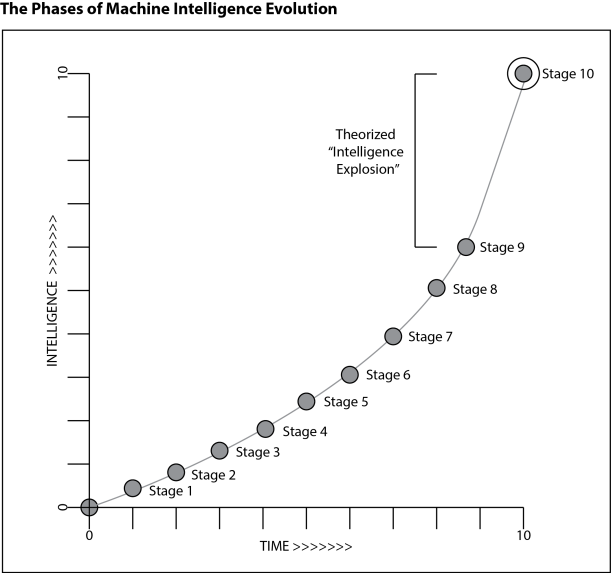I have been thinking and reading about artificial or machine intelligence for the last few years, considering primarily the major technical, social and ethical challenges involved, and my foresight-oriented thinking-in-progress has arrived at the desire to categorize the possible future worlds in which various evolutionary stages of machine intelligence will arrive. What follows is my framework for teasing out what the machine intelligence future might look like.
Imagine that we can identify and define ten distinct phases in order to track and understand the thresholds through which the development of machine intelligence might go through on its way to an eventual super-intelligence stage, a stage ten, also known as the “singularity.” Though an admittedly arbitrary number, these ten phases might allow for analysis and definition of machine intelligence evolution and allow us to isolate meaningful points in the process in order to understand what stage we’re at now, what future stages might look like, and what possible impacts these machine intelligence stages might have on the future societal constructs in which they might appear.
For analysis purposes, we can plot these ten phases over time, as in the chart here:
The idea here is that, given specific definitions of machine intelligence ability corresponding to each stage, we can also project from trends what kind of environment in which that stage will operate. The environment, now and in the future, is composed of the various dimensions of our global society, roughly something like in the chart below:
Any future component of the environment, from technology to economics, is likely to influence and be influenced to some degree interactively by all the others.
Given all this, key questions going forward become as follows:
- What defines each stage of machine intelligence? In other words, what capabilities or characteristics must machine intelligence exhibit to justify moving it from one stage to the next?
- When might we expect each stage to develop? Given technological progress and the solving of the various technical problems related to stage-to-stage improvement, when can we forecast the next stage?
- What will the world look like at each stage of machine intelligence advancement? How can we characterize the dimensions of society, economy, ecology, politics, etc. at the future hypothetical phases of machine intelligence development?
- Finally, given answers to the above questions, how will future world states impact the application and form of future machine intelligence phases, and vice versa?
I noted previously in a pessimistic post that I believe that machine super-intelligence is most likely a threat because it is most likely to arise into a world of conflict and competition. The more optimistic view going forward is to consider what we have to collectively do in all the other spheres of human activity to plan and construct the environment around each stage in the evolution of machine intelligence, so that as it develops, it develops in a positive, non-threatening way.
A lot of supposition here, I know, but if you get the stakes, it’s all worth thinking about.


